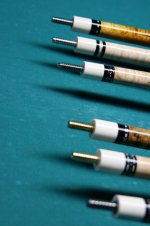Hi buddy,
Same cue maker (Rick Howard), same diameter, 2 original shafts from the same cue.
Taper should be close.
Shaft 1------------------------------------Shaft 2
old-grown maple wood-----------Curly maple wood
Ivory ferrule--------------------------Ferrule-less
30"---------------------------------------29.25"
3.2oz------------------------------------3.7oz
So the old-grown shaft is longer, has an ivory ferrule and still way lighter.
Biggest factor of course remains in the wood.
In fact, I am so surprise that how the old-grown shaft can be that light, given that it's a 30" with ivory ferrule. Crazy!
Anyway, it's my main player now. I have a Richard Harris with micarta ferrule but it's over 4oz, too heavy for me

.
I would love to have another one at 3.3oz, light shaft plays light-out hehe




